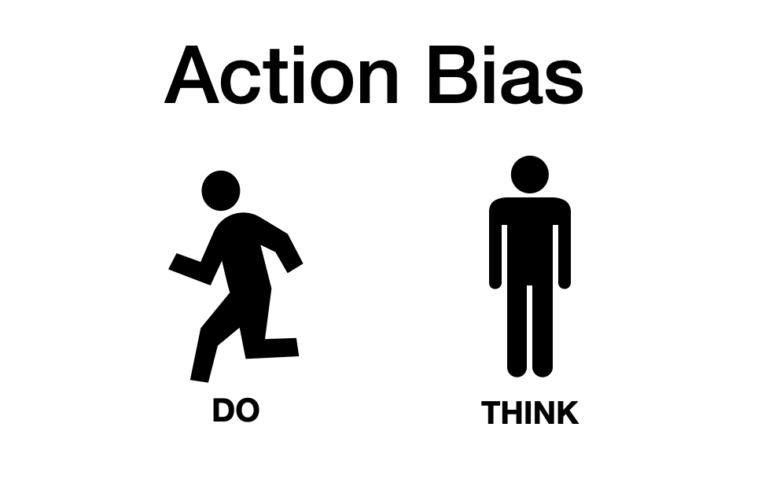
Hey guys. 代表Okadaです。
FIFA World Cupは残すところ、セミファイナルとファイナルのみとなりました。グループF出身のクロアチアとモロッコのカードが実現したら、日本のグループではなく、グループFが死のグループだったってことになりそうですね。
さて、前回FIFA World Cup ロシア大会のPK阻止率はおよそ25%、つまり、4回中1回はセーブがされています。クロアチア VS日本のときのように、4人蹴って3人をセーブする【75%】というキーパーもいますが、キッカー優位と言われるPenalty Kickで4人中1人をセーブする、くらいが限界なのではないかなあと感じます。
けれど、3回に1回はくるといわれる真正面にキックされたボールをはじけない、というのは、技術面やデータ分析以外では、どういった理由があるのでしょうか?
原因:Action Bias
Action Biasとは
2000年代前半から世の中で使われるようになった言葉で、政治、ビジネス、スポーツ、医学など様々な分野で書籍が販売されるようになったのは、2016-2017あたりからです。
Action Biasとは「行動しないよりも行動したほうがよいと私たちが考える傾向があるという心理的現象」です。行動した方が良い結果が生まれるという証拠がなくてもそうしてしまうことを選択するんですね。これは、合理的な思考に基づいているのではなく、反射とか衝動と似た自動反応です。初めて登場したのは2000年のBonston UniversityのPatt & Harvard UniversityのZechenhauser著のAction Bias and Environemental Decisionsという論文で政治においてのコンテクストで詳説されています。
サッカーではキーパーがその場でとどまるよりも、左右どちらかにとんだほうが好ましいという思考。
政治においては、政治家がマニフェスト「絶対〇〇します」に我々が好感を持つ。
医学だと、医者が特定の診断基準に達していない患者に、その診断を与えてしまい、結果誤診になる。
特に、自分にとって新たな状況や不明瞭な状況下において、Action Biasは働きやすくなります。
ゴールキーパーにおけるAction Bias
PKではキッカーが蹴ってからゴールまで0.3秒で到達します。ですから、蹴る前あるいはギリギリまで待って決断を下す必要があります。ここで重要なのが事前にチームマネージャーが相手のキックの傾向分析をしておいてキーパーと共有することですね。
さて、PKの際、キッカーが蹴るのはちょうど左、真ん中、右でそれぞれ3分の1の確率です(もちろんそこに右下、右上のように細分化はできます)。3分の1の確率で真ん中に来る可能性はあるわけですから、じっと待っておくというのも1つの戦略ですね。ところが、ほとんどの場合キーパーは左か右にとびます。これがAction Biasなんですね。
その原因は、下記Rolf Dobelli著のThe Art of Thinking Clearly のAction Biasの項によれば、真ん中にとどまっておくよりも、左右どちらかにとんだほうが、結果的にセーブできなかったとしても見栄えが良くなることが原因、つまり、体裁面の問題、だと述べられています。歴史的に見れば、私たちが狩猟採集民だったため、すぐに行動しなければ天敵に襲われてしまう危険性があったとも考えられます。
Why Watching and Waiting Is Torture: Action Bias
In a penalty situation in soccer, the ball takes less than 0.3 seconds from the player who kicks the ball to the goal. There is not enough time for the goalkeeper to watch the ball’s trajectory. He must make a decision before the ball is kicked. Soccer players who take penalty kicks shoot one third of the time at the middle of the goal, one third of the time at the left, and one third of the time at the right. Surely goalkeepers have spotted this, but what do they do? They dive either to the left or to the right. Rarely do they stay standing in the middle—even though roughly a third of all balls land there. Why on earth would they jeopardize saving these penalties? The simple answer: appearance. It looks more impressive and feels less embarrassing to dive to the wrong side than to freeze on the spot and watch the ball sail past. This is the action bias: Look active, even if it achieves nothing.
This study comes from the Israeli researcher Michael Bar-Eli, who evaluated hundreds of penalty shoot-outs. But not just goalkeepers fall victim to the action bias. Suppose a group of youths exit a nightclub and begin to argue, shouting at each other and gesturing wildly. The situation is close to escalating into an all-out brawl. The police officers in the area—some young, some more senior—hold back, monitor the scene from a distance, and intervene only when the first casualties appear. If no experienced officers are involved, this situation often ends differently: Young, overzealous officers succumb to the action biasand dive in immediately. A study revealed that later intervention, thanks to the calming presence of senior officers, results in fewer casualties.
The action bias is accentuated when a situation is new or unclear. When starting out, many investors act like the young, gung ho police officers outside the nightclub: They can’t yet judge the stock market so they compensate with a sort of hyperactivity. Of course this is a waste of time. As Charlie Munger sums up his approach to investing: “We’ve got … discipline in avoiding just doing any damn thing just because you can’t stand inactivity.”
The action bias exists even in the most educated circles. If a patient’s illness cannot yet be diagnosed with certainty, and doctors must choose between intervening (i.e., prescribing something) or waiting and seeing, they are prone to take action. Such decisions have nothing to do with profiteering, but rather with the human tendency to want to do anything but sit and wait in the face of uncertainty.
So what accounts for this tendency? In our old hunter-gatherer environment (which suited us quite well), action trumped reflection. Lightning-fast reactions were essential to survival; deliberation could be fatal. When our ancestors saw a silhouette appear at the edge of the forest—something that looked a lot like a saber-toothed tiger—they did not take a pew to muse over what it might be. They hit the road—and fast. We are the descendants of these quick responders. Back then, it was better to run away once too often. However, our world today is different; it rewards reflection, even though our instincts may suggest otherwise.
Although we now value contemplation more highly, outright inaction remains a cardinal sin. You get no honor, no medal, no statue with your name on it if you make exactly the right decision by waiting—for the good of the company, the state, even humanity. On the other hand, if you demonstrate decisiveness and quick judgment, and the situation improves (though perhaps coincidentally), it’s quite possible your boss, or even the mayor, will shake your hand. Society at large still prefers rash action to a sensible wait-and-see strategy.
In conclusion: In new or shaky circumstances, we feel compelled to do something, anything. Afterward we feel better, even if we have made things worse by acting too quickly or too often. So, though it might not merit a parade in your honor, if a situation is unclear, hold back until you can assess your options. “All of humanity’s problems stem from man’s inability to sit quietly in a room alone,” wrote Blaise Pascal. At home, in his study.
Action Biasの解決策
Inactionも選択し幅広く見てみる
不透明な状況下では、行動しないこと(inaction)をあえて選択するという戦略も提唱されています。これはネガティブな意味ではなく、Action Biasのかかる状況では冷静に判断・思考をせずに、直感と同じように対処してしまいます。そこで、そういった状況に遭遇したときには、「今Action Biasがかかっているかもしれない」と認識をすること、様々な選択肢を並べて広い視点で物事を俯瞰する癖付けをすることが重要です。医者の診断では、ある診断を下す際に基準にきっちりあてはまらない場合は、医者の主観で決めずに、様々な検査をすることで選択肢を増やし、誤診を防ぐ、というのが有名ですね。
未知の状況の体験を積む
これは学習でもそうです。大きなプレッシャーが資格試験などの状況では、普段やっていない行動をとったりするものです。例えば、問題を解く順番を、いつも練習ではエッセイライティングからしているけど、本番では、エッセイライティングのトピックが自分にはなじみがないものなので、リーディングから始めるという決断をくだす。結果的に時間が足りなくなった、という経験は多いのではないでしょうか?この時の現実的な解決策は、事前にエッセイライティングのトピックのネタを仕込んでおいて対応できるようにしておく、それでも反応できないトピックが出たときのために、練習段階で、リーディング-->ライティングという順番での練習もしておく、です。本番を意識したトレーニングを大量に積むことで、本番という圧がかかる状況でも冷静な対処ができるんですね。

英検を受ける高校生や社会人、大学受験の受験生には本番の1.5ヶ月前からタイムプレッシャーをかけて初見問題の演習を大量にするようにアドバイスをします。それまでは復習だけやっていればいいくらいの勢いで指導しているので受講生の皆さんは結構驚かれるのですが、直前期のアウトプットトレーニングは圧をかけることが重要で、その体験が本番でのプレッシャーに打ち勝ち、実力を出し切れる、ことにつながるんですね。プレッシャーをかけやすい方法として、問題の出し合いも有効だとされているので、是非学習パートナーを見つけて共同学習をしてみてください。
日本代表ならおそらく今後はJリーグなどでPK戦の導入というのもあり得るんじゃないでしょうか?
大学入試問題にも出題:2016年奈良女子大
上述したWhy Watching and Waiting Is Torture: Action Bias を一部改変していますが、実際に入試問題にもなっています。
FIFA World Cup 2022のPKセーブ率は25%超え?!
今回は前回大会に比べてPKのセーブ率が抜群に高い印象です。ロシア大会が4分の1でしたが、もしかすると、30%超えして、3分の1くらいになるかもしれませんね。
データ分析やテクノロジーを利用して科学的に成功率を高めようとしている昨今、もちろん、「効率よく」は必要ですし私も常に効率を上げる方法を考えていますが、土台は練習量、そして、長友選手のようなアツイ思いをどれだけ持てるかだと思います。効率性の中で省かれる無駄の部分にも意外と成長のヒントが隠れているものだな、と30台後半になって思う部分があります。今なにかの環境で「これって意味あるのか...?」とどうしても前向きになれないものと対峙している方は「この中で自分の成長につながるものは1つでもないか?」というプラスの視点に変えると、気持ちが楽になりますよ。
